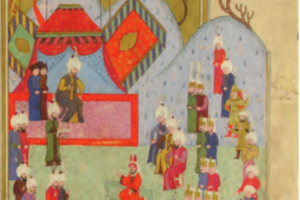Early Modern State Development in Yemen
The Zaydi imamate in Yemen was one of the longest surviving states in Muslim history. How did Zaydi imams maintain control over a region that appears impossible to rule? A Marie Skłodowska-Curie project studies the strategies and legacies of this polity.
The ongoing war and humanitarian crisis in Yemen seem to prove that its divisions can only produce a failed state. Yemen’s mountainous terrain, its diverse religious landscape that includes Shiʿis and Sunnis, and its long tradition of tribalism all seem to add to the country’s plight. But these divisions have not always been obstacles to state building in Yemen. In fact, Yemen boasts a long continuous history of statehood.
One long-surviving political regime in the region was a state founded in the tenth century by a Shiʿite group known as the Zaydis, the Zaydi imamate. Initially located in Upper Yemen, with the city of Ṣaʿda as its capital, the imamate strove to establish control over the mountainous territory inhabited by tribes. This was not an easy process, as the Zaydi imamate had to face powerful competitors, rulers of Lower Yemen, like the Rasulid dynasty and their successors, the Tahirids. For centuries, Yemen was divided into a northern, predominantly mountainous, part ruled by the Zaydi imams and a southern, predominantly coastal, part ruled by Sunni dynasties.
A turning point came in 1517, a transformative year for many regions of the Arab Middle East. At that time, the Zaydi imam al-Mutawakkil Yaḥyā Sharaf al-Dīn was attempting to consolidate his rule in the regions near Ṣanʿāʾ. In this he was unexpectedly aided by events outside his control. In response to the arrival of European ships in the Indian Ocean and the Red Sea, an Egyptian Mamluk expeditionary corps came to Yemen. However, instead of attacking the Portuguese, against whom they were sent, the Mamluks directed their efforts to conquering Yemen. Within a year they found themselves stranded due to the Ottoman conquest of Egypt. With the Mamluk forces weakened, imam Yaḥyā Sharaf al-Dīn became the sole powerful ruler of the region and united the north and south of Yemen. This was the first time in Yemen’s history that a Zaydi ruler controlled the entirety of the region. Thus began a century of immense transformations for Yemen and the Zaydi imamate.

While imam Yaḥyā Sharaf al-Dīn was expanding the territory under his control and consolidating his rule, the Ottomans, who by now controlled all the Middle East and Egypt, directed their attention to the Arabian Peninsula. From the 1530s onwards, the Ottomans were increasing their presence in South-West Arabia. By the time of Yaḥyā Sharaf al-Dīn’s death in 1558, his once expansive imamate had shrunk to a few small principalities controlled by his sons, now allies and tributaries of the Ottoman sultan. Thus, in the lifetime of a single generation, the shape of the political system in Yemen radically changed.


What followed next was an ‘Ottoman century’ (1538–1635) during which Yemen was part of one of the most powerful empires of the early modern period. Ottoman rule appeared to have been installed in the region for perpetuity. This was, however, not the end of the Zaydi imamate. Zaydi imams continued to challenge the Ottomans in Yemen. In 1597, a new Zaydi imam brought together allies from the peripheries of Yemen and built up an opposition to Ottoman rule. This imam was al-Manṣūr Qāsim b. Muḥammad; he gave the name to the Qasimid dynasty of Zaydi imams, who eventually ousted the Ottomans and rebuilt the expansive Zaydi imamate of the Sharaf al-Dīn era.
How did the Zaydis succeed in building resilient alliances and institutions in a country, divided by impenetrable mountain ranges, in which tribal populations were always eager to exercise their autonomy and religious divisions made alliances between different denominations of Muslims tenuous? How was it possible for the Zaydi imamate to come back onto the political scene after the Ottoman conquest and eventually to take over control of the region from one of the most powerful empires of the early modern period? EMStaD YEMEN, a Marie Skłodowska-Curie research project, based at Leiden University (2022–2024) aims to explain why, despite the existence of the very same divisions that are supposed to undermine the state in contemporary Yemen, a resilient political system existed there in the early modern period.
Central to the research project is the period of imam Yaḥyā Sharaf al-Dīn’s rule (1506–1558). Because this imam ruled over a significantly larger territory than any of his Zaydi predecessors and because his imamate encompassed a greater variety of social and religious groups, his time in power was a period of political and administrative innovation for the Zaydi imamate. This imam relied on a more organized bureaucracy, which involved his relatives as well as scholars (ʿulamāʾ). He also experimented with new approaches to tribal incorporation into the imamate. Even though Zaydi political theory did not have provisions for dynastic transfer of power, this imam tried to lay a foundation for a system of succession.
In the long run, imam Yaḥyā Sharaf al-Dīn’s reforms were foundational to the rule of both the Ottomans and the Qasimids. Despite his innovations and legacy, we know surprisingly little about the mechanisms by which he reshaped the Zaydi state. Relying on several previously unstudied manuscript sources, including materials from the Leiden University Library collection, EMSTaD YEMEN sheds light on this transformative period in Zaydi history and contextualizes it within broader developments of early modern world history.



0 Comments